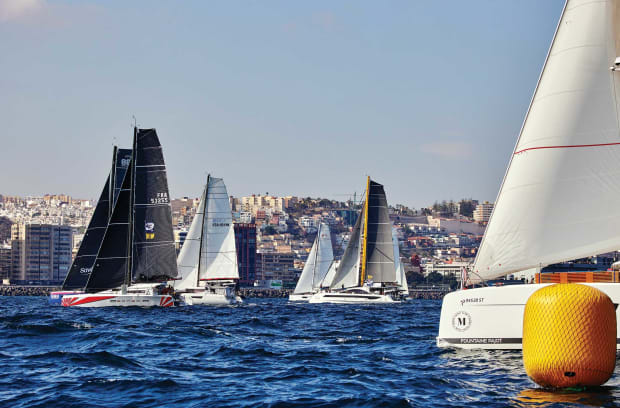
Photo courtesy of James Mitchell/WCC
The days of multihulls being the weirdos of the sea are gone. Nothing illustrated this better than the 2021 Atlantic Rally for Cruisers (ARC), which departed Las Palmas de Gran Canaria (in Spain’s Canary Islands) in November and wrapped up in December on the island of St. Lucia in the Caribbean. Of the 143 boats that crossed the starting line of the 3,000-mile voyage, 32 were multihulls, mostly cats with a smattering of trimarans as well.
The ARC has been running 36 consecutive years, ever since the first one was organized by the World Cruising Club (WCC: worldcruising.com) in 1986, and multihulls are increasingly visible. This ARC was rough, with 15ft seas and 40-knot winds barreling down on the fleet about a week after an unusually slow (and upwind) start. Nonetheless, the crews on cats fared well. Many commented that they appreciated the more stable platform of multiple hulls and that it enabled them to be more rested and make better decisions.
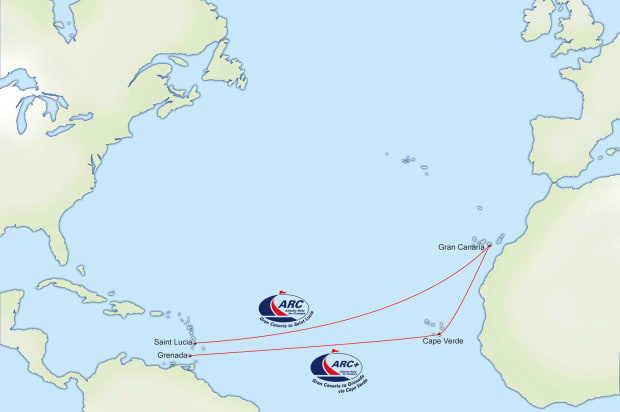
Map courtesy of WCC
Meet the Crews
I caught up with some of the crews in Rodney Bay on St. Lucia around the time of the event’s conclusion. Many of the boats had already arrived, although some never entered the marina, deciding instead to cross the finish line and then head north to Martinique to avoid having to deal with Covid rules on two different islands. Other boats like the Outremers Moxie and Luna Bay had either left already or were closed up with the crews off enjoying the island. There was even one powercat, a brand new Sunreef 80, that crossed with the group, commanded by a professional crew. It will cruise the Caribbean with the owners until April when it will be sold.
That last part really underscored the new attitude that was pervasive throughout the ARC this year. Given the current state of the industry, where boats are hard to come by and aren’t depreciating as quickly as usual, some may have purchased new boats knowing they could have an adventure and then sell them right after and not lose any money. The boats were also larger overall, and the crews on both monohulls and multis were both younger and focused on more modern equipment, like IridiumGo rather than SSB radios, among other pushbutton conveniences. Many were either working remotely or had merely interrupted their careers to have a bold adventure as opposed to having retired. Their offshore experience was light, and their boats were newish. The average age for the multihulls was just two years old compared with 14 years for the monohulls. An impressive 80 percent of the multis were less than a year old.
Finally, many of the skippers and crews weren’t tied to sailing long term. They’d bought their boat, had their adventure and were ready to sell up and move on to the next checkbox on their list. It’s an approach that ruffles the feathers of some old-timers. But such is the reality of offshore sailing these days.
Bombarda – Excess 11 (Dutch) 18 Days 23 Hours
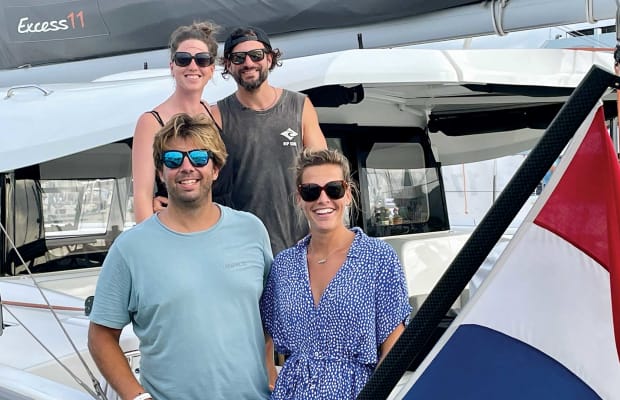
Photo by Zuzana Prochazka
Perhaps the best example of the changing ARC was Bombarda, a 2021 Excess 11 that Dutch owner, Marco, had taken delivery of just a few months before the start. His experience with monohull sailing was deep, having grown up on sailboats. But this was his first multihull, and his crew, Lizzy, Susanne and Claudio were total newbies—young sailors in their 20s and 30s out for a bit of fun after having been forced to sit out Covid for a year. Marco and Lizzy both work remotely. (Marco owns an outfit with shared electric scooters; Lizzy has coffee bars and a catering business.) “I had to do a PowerPoint presentation for the crew to bring them up to speed on sailing essentials,” Marco said of his preparation prior to casting off lines in Las Palmas.
The crew had apparently decided that sailing across the ocean sounded like fun after months of being cooped up. Two weeks later they bought the boat and had it outfitted. They liked the space of a multihull since they’re avid kite surfers and it can stow lots of gear. They felt the 37ft boat was affordable and spent quite a bit on outfitting it with solar panels and lithium batteries. They were quick to point out that their carbon fiber flagpole (probably worth thousands of euros) was a gift from the dealer.
They eschewed conventional equipment like an SSB radio, relying exclusively on satellite communications for staying in touch—again, an approach that was fairly standard among the younger set on the rally. They did a mid-trip pirates and mermaids party complete with costumes and never once felt bored with the same view from the cockpit, savoring the time to contemplate life. “I read the Godforesaken Sea along the way,” said Marco, “Maybe that wasn’t the best choice for a first-time crossing.”
Saga 1 – Fountaine Pajot Saona 47 (Sweden) 21 Days 20 Hours
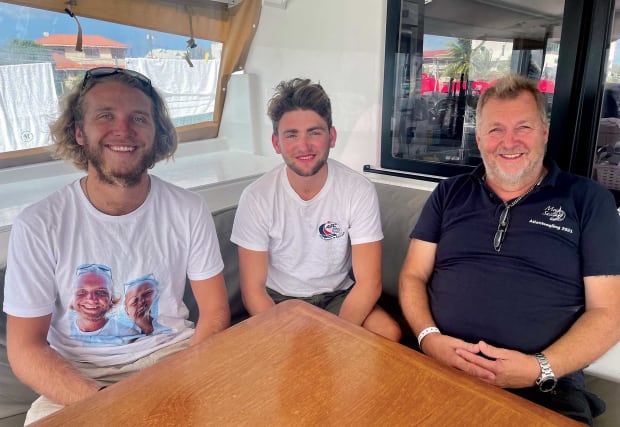
Photo by Zuzana Prochazka
Viktor was the young captain of Saga 1, a commercial entry that carried three crew and eight paying passengers, all male and all Swedish. I sat down with Viktor and crewmember Sam in the cockpit, and like the group on Bombarda, both were pretty jolly.
They’d lost their Windex early on, and although Viktor went up the mast three times to fix things, they ended up having to do without wind instruments for the majority of the trip. Maybe that’s why they blew out their gennaker so quickly. They averaged 15-16 knots, topping out at one point at 20.4 knots with two reefs in the main.
Although the ages aboard ranged from 21 to 70, the crew gelled well despite a candy crisis when they ran out of chocolate. Sam was always busy tweaking something, and they tried to pick up as much of the plastic garbage they found floating in the water along the way.
“I thought I’d get bored of looking at the ocean,” said Viktor. “I brought lots of reading material, but I never cracked a book.” They agreed that the stability of a multihull is bliss. “Our big issue was that our playing cards blew around some.” Tough life!
Nenya – Lagoon 39 (Sweden) 22 Days 5 Hours
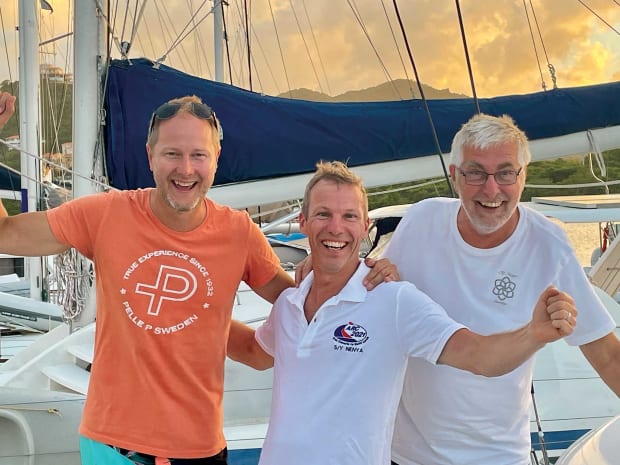
Photo by Zuzana Prochazka
Another boat in good spirits was Nenya, with Swedish owner Vidar, his father-in-law and a number of friends. Vidar had bought the boat in Oslo, and in addition to it being his first multihull this had been his first Atlantic crossing.
The slow start was tough on the boat, especially since it was mostly upwind in the beginning, which isn’t a fun angle of sail for a cruising cat. Once the wind changed, though, Nenya was in her element. The crew’s favorite pieces of equipment included Nenya’s induction stove (no open flame), the boat’s autopilot and watermaker. They caught three mahi mahi and four tuna, and tossed one of their fish to another boat that was looking for dinner. Vidar celebrated his 47th birthday on the crossing, which was a highlight, as was not having to stow everything the way he had in the past aboard his monohulls, because on cats, stuff doesn’t fly around quite as much.
Nothing underscored the differences between the monohull and multihull experience better than Nenya. While sailors on monohulls were tossed about to the point of not sleeping or eating for days, those on cats like the Lagoon 39 remained in relative comfort.
“We were surprised by the rough weather, but we didn’t have the hardship of the crews on the monohulls,” said Vidar. “We spent some time watching movies and eating popcorn, although we did develop a small leak in the corner of our dishwasher.”
Curvy Mermaid – Lagoon 42 (Italy) 22 Days 5 Hours
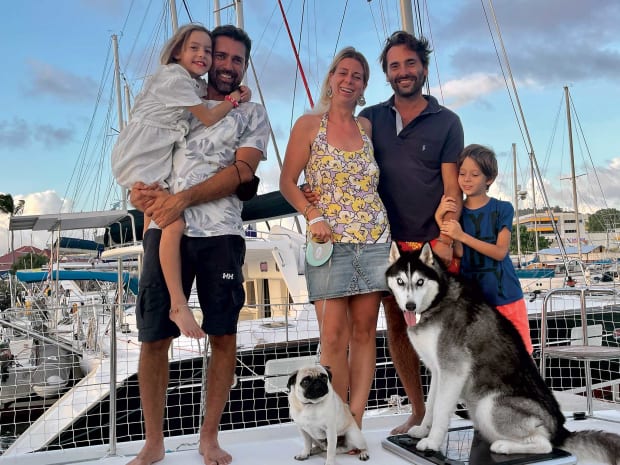
Photo by Zuzana Prochazka
I could hear the laughter all the way down the dock, as I made may way toward Curvy Mermaid, a 2016 Lagoon where I found Ricardo and Sina, and their young kids Maxine and Emilio. I was also welcomed aboard by Bruce and Koda, a pug and a husky who were only too happy to meet a new sucker ready to pay them lots of attention.
The family’s story is mind-boggling. They had bought their boat the previous summer and with only a few months of sailing experience, signed up for the ARC as a way to get to their new home waiting for them in the Bahamas. None of them were sailors except for one crew who jumped aboard in Las Palmas. Ricardo had basically learned all about sailing by watching two years of YouTube videos. “If you can learn visually, then it’s all totally doable,” he said. Sina, who was less than thrilled with their adventure, said she’d never do it again, but had complete confidence in her husband. “He’s really good, but it’s hard not to sleep for 14 days.”
The kids were none worse for the wear, and the dogs seemed content too. “The hardest thing was worrying about Koda who wouldn’t use the Astroturf in the cockpit to do his business and kept going out on the bows,” said Ricardo. “Also seeing my wife so scared.”
As for the kids, they said they were thrilled by the dolphins and watching squalls on the chartplotter, which they treated like video games. Ricardo agreed that this was not an adventure for beginners, and that it would have been good to have spent more time sailing at night and in rough conditions before setting out. Nonetheless, the entire time I was aboard, they never once stopped laughing and having fun. “You only regret the things you don’t do,” said Ricardo, adding: “And you forget the tough times.”
Balukami –Tournier Freydis 49 (Austria) 24 Days 1 Hour
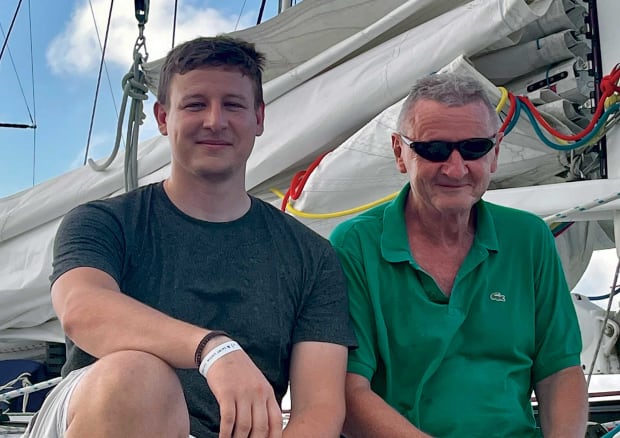
Photo by Zuzana Prochazka
Eduard and his oldest son, Sebastian, were aboard Balukami when I stopped by. The boat was a 2015 French cat they had bought and finished out themselves. Eduard was no stranger to sailing, with lots of experience in Optimists and racing in the Pacific Cup on the West Coast of the United States. He may have started in monohulls, but described himself as a diehard multihull sailor for the past 25 years, which puts him way ahead of the curve.
The trip was a stress test for the boat. They chafed through a sheet, broke the topping lift and had a blocked fuel line. Because the start was so slow and required motoring, they cut back drastically on power usage to save precious fuel they might need later for charging. Once the wind changed, however, they were figuring out ways to slow the boat down, even as they ran with a third reef in the main.
Eduard seemed delighted to have had concentrated time with his sons, and he enjoyed the vastness of the ocean with no Internet access aside from limited IridiumGo communication. His advice was that you don’t have to be an expert, but you do have to plan, adding that for him, this was the perfect start to his retirement. “The crew was good, no panic and no ego,” he said. “In the end, the boat can do more than the crew. You can’t focus on the risks. They’re everywhere.”
Amelia – Privilege 585 (US) 22 Days 15 Hours
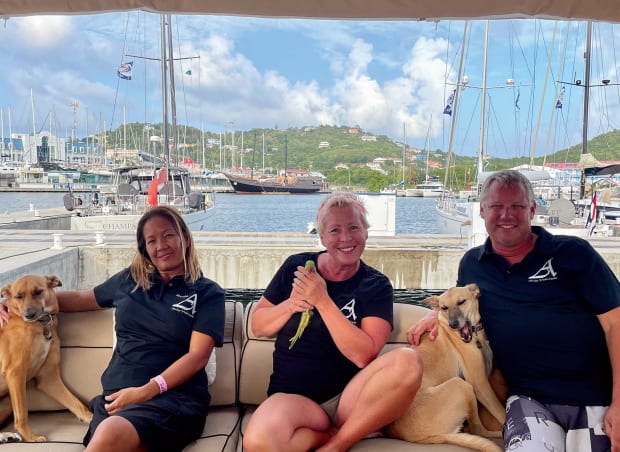
Photo by Zuzana Prochazka
I found Karl and Michelle aboard their sprawling, near-60ft cat on the “big yacht” side of the marina. I couldn’t have snuck up on them if I’d tried thanks to their two rescue dogs and not-to-be-missed alarms. They had crossed with Ricardo, a crewmember from Mexico, and Roda, their Filipina housekeeper when they’d lived in Dubai, one of a number of places Karl has been based as an airline pilot. Covid had accelerated their 15-year cruising dream, prompting them to buy their boat in Germany, sell everything and set sail.
They’d averaged 8.8 knots for five days and 7.2 knots over the course of the entire passage. They’d even snuck in a 210-mile day at one point. Because they wanted to come in rested and during daylight, they’d slowed down at the end and all were quite relaxed and happy with their transit. “I feel proud of us,” said Michelle. “It was weird to think about all those thousands of feet of water below us, but I felt at home.”
Karl, no stranger to big machines, said he was nonetheless awed by the forces aboard a boat as big as his. “It’s a beast to tame in 25-knot winds, especially at night,” he said. “It took all four of us to get the gennaker down.”
Michelle, who is a long-time advocate for animal rescue, also had three parrots aboard who had made the transit down below. She calls the whole clan her “family,” and it’s likely she’ll pick up something new wherever they go next. As for Roda, she’s become a celebrity in her hometown in the Philippines and now keeps an active Instagram account of her adventures. She was philosophical about her newfound cruising circumstances. “It’s all a big part of my life,” she said by way of summary.
Multihull Sailor Summer 2022








